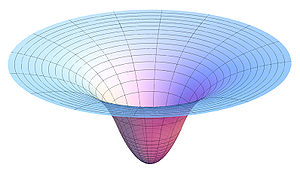


Inphysics, a force field is a vector field corresponding with a non-contact force acting on a particle at various positions in space. Specifically, a force field is a vector field 


 , where the radial unit vector
, where the radial unit vector  points away from the particle. The gravitational force experienced by a particle of light mass m, close to the surface of Earth is given by
points away from the particle. The gravitational force experienced by a particle of light mass m, close to the surface of Earth is given by  , where gisEarth's gravity.[3][4]
, where gisEarth's gravity.[3][4] exerts a force on a point charge q, given by
exerts a force on a point charge q, given by  .[5]
.[5] , a point charge moving through it experiences a force perpendicular to its own velocity and to the direction of the field, following the relation:
, a point charge moving through it experiences a force perpendicular to its own velocity and to the direction of the field, following the relation:  .
.Work is dependent on the displacement as well as the force acting on an object. As a particle moves through a force field along a path C, the work done by the force is a line integral:

This value is independent of the velocity/momentum that the particle travels along the path.
For a conservative force field, it is also independent of the path itself, depending only on the starting and ending points. Therefore, the work for an object travelling in a closed path is zero, since its starting and ending points are the same:

If the field is conservative, the work done can be more easily evaluated by realizing that a conservative vector field can be written as the gradient of some scalar potential function:

The work done is then simply the difference in the value of this potential in the starting and end points of the path. If these points are given by x = a and x = b, respectively:

| Authority control databases: National |
|
|---|